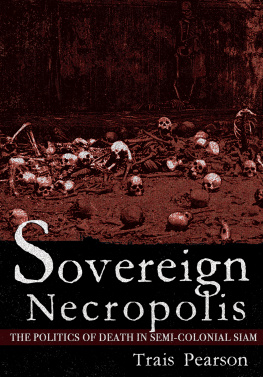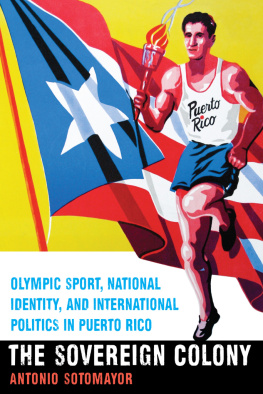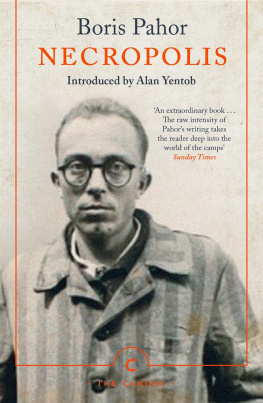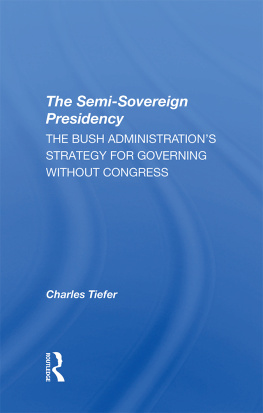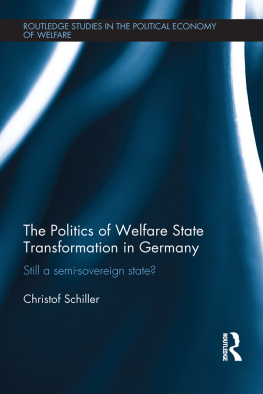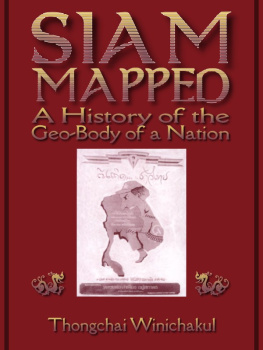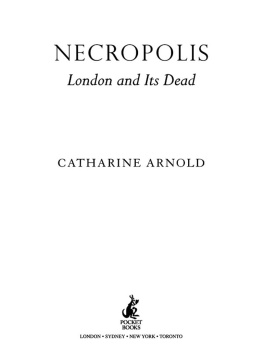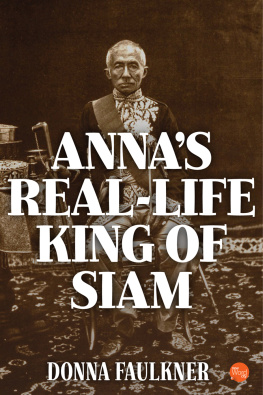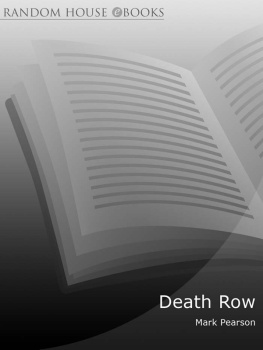SOVEREIGN NECROPOLIS
THE POLITICS OF DEATH IN SEMI-COLONIAL SIAM
T RAIS P EARSON
CORNELL UNIVERSITY PRESS
Ithaca and London
To Phi Pha and the Sukwong Family, who took in a twenty-one-year-old wanderer and helped him find his way.
To Su-Ping, Quinn, and Josephinethe life and light in my world.
Archives do not record experience so much as its absence; they mark the point where an experience is missing from its proper place, and what is returned to us in an archive may well be something we never possessed in the first place.
Sven Spieker, The Big Archive: Art from Bureaucracy
The chronicler, who recounts events without distinguishing between the great and the small, thereby accounts for the truth, that nothing which has ever happened is to be given as lost to history.
Walter Benjamin, Selected Writings, Volume 4, 19381940
C ONTENTS
N OTE ON N AMING C ONVENTIONS , S OURCES , T RANSCRIPTION , AND T RANSLATION
The nation-state of Thailand was known as the Kingdom of Siam until 1939. In the interest of historical accuracy, I refer to the polity and its population as Siam and Siamese, respectively, throughout most of this book. I have followed the Royal Thai General System of Transcription (1999) with some minor changes: I have transliterated

as
j when it appears in initial position (as in
jao phraya or
jao phanak ngan). Other exceptions have been made to conform to recognized spelling conventions in the case of proper names (e.g., Chulalongkorn).
I have chosen to retain Thai-language titles and honorifics more or less in accordance with their historical usages in the archival documents. These include markers of age, gender, (commoner) social status, and ethnicity such as amdaeng (Miss), nai (Mister), and jin (the ethnic marker for a male of Chinese birth or ancestry). Readers will also note three distinct titles used to signify medical expertise: (1) the English-language title Doctor (Dr.) was used to refer almost exclusively to Western-born and Western-educated physicians; (2) the Thai term phaet was also used in reference to these doctors, as well as Thai (or other non-Westerners) whose medical training was recognized as being in the Western tradition; (3) the term mo was typically used to refer to physicians trained in Siamese or local Asian medical traditions. Finally, the title phra was used in two contexts: when it appears before a Buddhist monks personal name, the term is an honorific meaning Venerable. When used before a civil servants name, it signifies a bureaucratic rank, as in Phra Thep Phlu, with phraya and jao phraya signifying elevated ranks or offices. In the case of individuals who appear throughout the study but whose titles and ranks may have changed along with their office, I have elected to use a single, consistent honorific to aid in recognition; such is the case with Prince Naret Worarit, who occupied the office of Minister of the Capital during seminal years covered in this book.
The Siamese currency was in flux during the transitional period discussed in this book. Foreign-language sources most commonly used the Portuguese/Malay loanword tical when referring to the Siamese currency until 1897, when it was standardized using a decimal system whereby one hundred satang equaled one baht. The term catty (plural: catties; Thai: chang) referred to a larger denomination of the Siamese currency; it was based on a standardized Chinese measure of weight. One catty amounted to eighty baht (or ticals).
The empirical core of this book is a collection of documents from the National Archives of Thailand labeled Death by various causes (tai duai het tang tang; NA R5 N 23). The collection consists of the documentary records of inquests, or investigations into cases of unnatural or suspicious deaths in the Siamese capital city beginning in 1890. They are a diverse and uneven lot, containing voices ranging from illiterate subalterns to the king himself, often treading on every rung of the cosmopolitan social ladder in between. In making sense of and ultimately translating portions of these documents, I have benefited greatly from the help of Sirinan Bunsri and Ngampit Jagacinski. Any errors, of course, are my own.
In the only other work of published scholarship to make extensive use of the inquest files, Takashi Tomosugi has analyzed the documents as evidence of the changing nature of urban lives at that time; see his Reminiscences of Old Bangkok: Memory and the Identification of a Changing Society ([Tokyo]: The Institute of Oriental Culture, University of Tokyo, 1993), 13150. These documents deserve much greater attention, and I urge scholars to pay them their due. Like the dead whose passings they recount, they have been hiding in plain sight for too long.
Introduction
The life of sovereign power is a life that is lived in the shadow of deathmany deaths, nameless and innumerable, disavowed and forgotten.
Stuart J. Murray, Thanatopolitics: On the Use of Death for Mobilizing Political Life
On July 19, 1906, the queen consort of King Chulalongkorn of Siam was involved in a fatal car accident when the motorcar she was traveling in struck and killed a pedestrian in central Bangkok. Although the queen informed the king of the event the next morning, seven days passed before news of the accident reached him through official channels in the Siamese bureaucracy. Chulalongkorn was incensed. He penned a letter to the responsible party, noting, Since time immemorial, whenever a human being died under unusual circumstancessuch as being struck by lightning, burned in a fire, drowning, or being stabbed or shotwhether by an act of the Gods or not, if it happened in this city it was the duty of the Ministry of the Capital to report it to the king without delay.
Chulalongkorns letter might be seen as in keeping with a paternalistic vein in the Thai monarchical tradition. It harkens back to a pastoral kingdom where the subjects did not want owing to the fish in the water and rice in the fields, and where petitions could be voiced to the sovereign himself, who hung a bell over the palace gate and if any commoner in the land has a grievance which sickens his belly and gripes his heart he goes and strikes the bell which the King has hung there; King Ramkhamhaeng, the ruler of the kingdom, hears the call; he goes and questions the man, examines the case, and decides it justly for him. In this reading, Chulalongkorns concern for the dead resounds as a beneficent extension of the Siamese kings traditional mandate as Lord of Life (jao chiwit) to include jurisdiction over the dead as well. There is, however, an alternative reading, one that hints at darker realities of modern Thai history. In that view, the sovereigns concern for the dead is not a simple ethnographic anomaly, a testament to some ahistorical facet of Thai culture, but is rather a vision of Siamese political culture that intersected in crucial ways with the reality of the kingdoms semi-colonial status and the pragmatic actions being taken by the state to address those conditions.
By the turn of the twentieth century, the Siamese kings sovereign power over both the living and the dead had been dramatically curtailed. Since the mid-nineteenth century, unequal trade treaties had granted extraterritorial legal privileges to foreign residents. Consular courts administered justice to the growing contingent of foreigners residing in Siam, including immigrants from across Asia who likewise claimed privileged status as protgs (protected subjects) of the imperial powers. Bangkok, the Siamese royal capital, a cosmopolitan city of some half a million residents, thus became a plural legal arena, and deathespecially death under unnatural, accidental, or suspicious circumstances, which might entail civil or criminal legal actionbecame a matter of transnational concern and expert intervention. Barristers, physicians, police, consular officials, juries, and newspaper editors all disputed the Siamese monarchs claim to power over life and death, raising questions of evidence, liability, and jurisdiction.
 as j when it appears in initial position (as in jao phraya or jao phanak ngan). Other exceptions have been made to conform to recognized spelling conventions in the case of proper names (e.g., Chulalongkorn).
as j when it appears in initial position (as in jao phraya or jao phanak ngan). Other exceptions have been made to conform to recognized spelling conventions in the case of proper names (e.g., Chulalongkorn).
